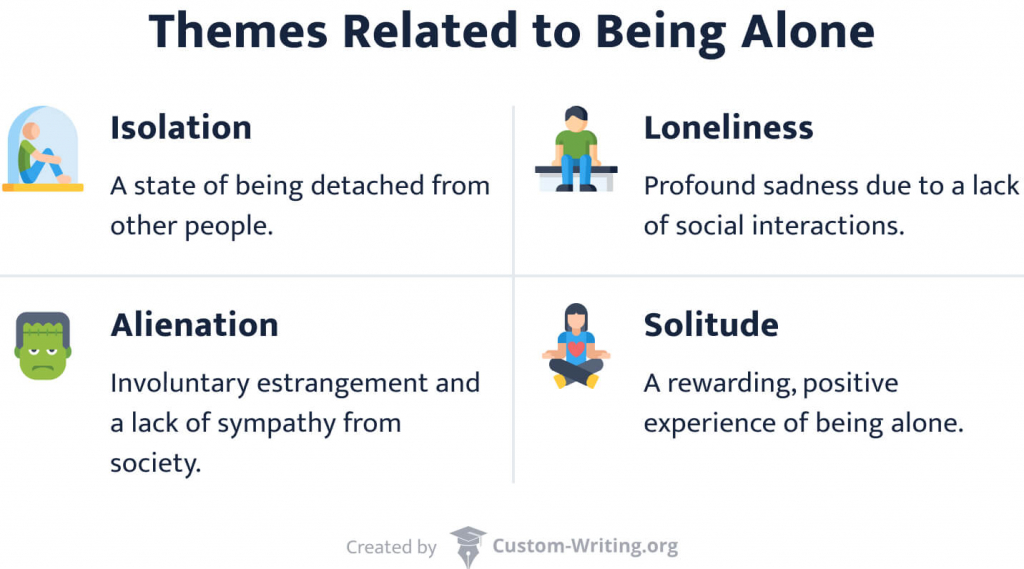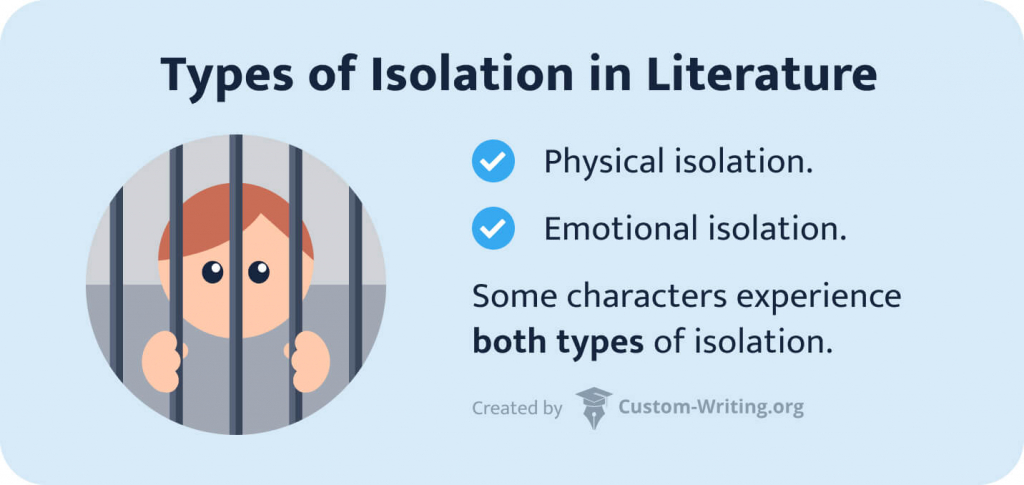World literature offers countless works that explore themes about loneliness and isolation, examining their positive and negative aspects. Authors often focus on psychological perspectives of solitude and its impact on mental health or delve into one’s feelings of alienation and societal rejection. Another crucial angle is how the theme of loneliness reflects broader societal conditions such as industrialization, war, and the pressures of modern life.
In this article, the Custom-Writing.org team:
- Examines the distinctions between loneliness, isolation, and alienation.
- Explores the various types of loneliness and isolation in literature.
- Analyzes how they are portrayed in iconic works: Frankenstein, The Metamorphosis, and Of Mice and Men.
- Suggests engaging essay topics to deepen your understanding of the theme of loneliness.
🏝️ Isolation Theme in Literature
Isolation is a state of being detached from other people, either physically or emotionally. It may have positive and negative connotations:
- In a positive sense, isolation can be a powerful source of creativity and independence.
- In negative terms, it can cause mental suffering and difficulties with interpersonal relationships.

Theme of Isolation and Loneliness: Difference
As you can see, isolation can be enjoyable in certain situations. That’s how it differs from loneliness: a negative state in which a person feels uncomfortable and emotionally down because of a lack of social interactions. In other words, isolated people are not necessarily lonely.
Isolation Theme Characteristics with Examples
Now, let’s examine isolation as a literary theme. It often appears in stories of different genres and has various shades of meaning. We’ll explain the different uses of this theme and provide examples from literature.
Forced vs. Voluntary Isolation in Literature
Isolation can be voluntary or happen for external reasons beyond the person’s control. The main difference lies in the agent who imposes isolation on the person:
- If someone decides to be alone and enjoys this state of solitude, it’s voluntary isolation. The poetry of Emily Dickinson is a prominent example.
- Forced isolation often acts as punishment and leads to detrimental emotional consequences. This form of isolation doesn’t depend on the character’s will, such as in Hawthorne’s The Scarlet Letter.
Physical vs. Emotional Isolation in Literature
Aside from forced and voluntary, isolation can be physical or emotional:

- Isolation at the physical level makes the character unable to reach out to other people, such as Robinson Crusoe being stranded on an island.
- Emotional isolation is an inner state of separation from other people. It also involves unwillingness or inability to build quality relationships. A great example is Holden Caulfield from The Catcher in the Rye.
These two forms are often interlinked, like in A Rose for Emily. The story’s titular character is isolated from the others both physically and emotionally.
Symbols of Isolation in Literature
In literary works dedicated to emotional isolation, authors often use physical artifacts as symbols. For example, the moors in Wuthering Heights or the room in The Yellow Wallpaper are means of the characters’ physical isolation. They also symbolize a much deeper divide between the protagonists and the people around them.
🏠 Theme of Loneliness in Literature
Loneliness is often used as a theme in stories of people unable to build relationships with others. Their state of mind always comes with sadness and a low self-esteem. Naturally, it causes profound emotional suffering.
We will examine how the theme of loneliness functions in literature. But first, let’s see how it differs from its positive counterpart: solitude.
Solitude vs. Loneliness: The Difference
Loneliness Theme: History & Examples
The modern concept of loneliness is relatively new. It first emerged in the 16th century and has undergone many transformations since then.
- The first formal mention of loneliness appeared in George Milton’s Paradise Lost in the 17th century. There are also many references to loneliness in Shakespeare’s works.
- Later on, after the Industrial Revolution, the theme got more popular. During that time, people started moving to large cities. As a result, they were losing bonds with their families and hometowns. Illustrative examples of that period are Gothic novels and the works of Charles Dickens.
- According to The New Yorker, the 20th century witnessed a broad spread of loneliness due to the rise of Capitalism. Philosophers Jean-Paul Sartre and Albert Camus explored existential loneliness, influencing numerous authors. The absurdist writings of Kafka and Beckett also played an essential role in reflecting the isolation felt by people in Capitalist societies. Sylvia Plath has masterfully explored mental health struggles related to this condition in The Bell Jar (you can learn more about it in our The Bell Jar analysis.)
👽 Theme of Alienation in Literature
Another facet of being alone that is often explored in literature is alienation. Let’s see how this concept differs from those we discussed previously.
Alienation vs. Loneliness: Difference
While loneliness is more about being on your own and lacking connection, alienation means involuntary estrangement and a lack of sympathy from society. In other words, alienated people don’t fit their community, thus lacking a sense of belonging.
Isolation vs. Alienation: The Difference
Theme of Alienation vs. Identity in Literature
There is a prominent connection between alienation and a loss of identity. It often results from a character’s self-search in a hostile society with alien ideas and values. These characters often differ from the dominant majority, so the community treats them negatively. Such is the case with Mrs. Dalloway from Woolf’s eponymous novel.
Writers with unique, non-conforming identity are often alienated during their lifetime. Their distinct mindset sets them apart from their social circle. Naturally, it creates discomfort and relationship problems. These experiences are often reflected in their works, such as in James Joyce’s semi-autobiographical A Portrait of the Artist as a Young Man.
Alienation in Modernism
Alienation as a theme is mainly associated with Modernism. It’s not surprising, considering that the 20th century witnessed fundamental changes in people’s lifestyle. Capitalism and the Industrial Revolution couldn’t help eroding the quality of human bonding and the depth of relationships.

It’s also vital to mention that the two World Wars introduced even greater changes in human relationships. People got more locked up emotionally in order to withstand the war trauma and avoid further turmoil. Consequently, the theme of alienation and comradeship found reflection in the works of Ernest Hemingway, Erich Maria Remarque, Norman Mailer, and Rebecca West, among others.
📚 Books about Loneliness and Isolation: Quotes & Examples
Loneliness and isolation themes are featured prominently in many of the world’s greatest literary works. Here we’ll analyze several well-known examples: Frankenstein, Of Mice and Men, and The Metamorphosis.
Theme of Isolation & Alienation in Frankenstein
Mary Shelley’s novel Frankenstein is among the earliest depictions of loneliness in modern literature. It shows the depth of emotional suffering that alienation can impose.
Victor Frankenstein, a talented scientist, creates a monster from the human body parts. The monster becomes the loneliest creature in the world. Seeing that his master hates him and wouldn’t become his friend, he ruined everything Victor held dear. He was driven by revenge, trying to drive him into the same despair.
The novel contains many references to emotional and physical alienation. It also explores the distinction between voluntary and involuntary isolation:
- The monster is involuntarily driven into an emotionally devastating state of alienation.
- Victor imposes voluntary isolation on himself after witnessing the crimes of his creature.
To learn more about the representation of loneliness and isolation in the novel, check out our article on themes in Frankenstein.
Frankenstein Quotes about Isolation
Here are a couple of quotes from Frankenstein directly related to the theme of isolation and loneliness:
How slowly the time passes here, encompassed as I am by frost and snow…I have one want which I have never yet been able to satisfy and the absence of the object of which I now feel as a most severe evil. I have no friend.
Frankenstein, Robert Walton, Letter 2
In this quote, Walton expresses his loneliness and desire for company. He uses frost and snow as symbols to refer to his isolation. Perhaps a heart-warming relationship could melt the ice surrounding him.
I believed myself totally unfitted for the company of strangers.
Frankenstein, Victor Frankenstein, Chapter 3
This quote is related to Victor’s inability to make friends and function as a regular member of society. He also misses his friends and relatives in Ingolstadt, which causes him further discomfort.
I, who had ever been surrounded by amiable companions, continually engaged in endeavouring to bestow mutual pleasure—I was now alone.
Frankenstein, Victor Frankenstein, Chapter 3
In this quote, Victor shares his fear of loneliness. As a person who used to spend most of his time in social activity among people, Victor feared the solitude that awaited him in Ingolstadt.
Isolation & Alienation in The Metamorphosis
The Metamorphosis is an enigmatic masterpiece by Franz Kafka, telling a story of a young man Gregor. He is alienated at work and home by his demanding, disrespectful family. He lacks deep, rewarding relationships in his life. As a result, he feels profound loneliness.

Gregor’s family isolates him both as a human and an insect, refusing to recognize his personhood. Gregor’s stay in confinement is also a reflection of his broader alienation from society, resulting from his self-perception as a parasite. To learn more about it, feel free to read our article on themes in The Metamorphosis.
The Metamorphosis: Isolation Quotes
Let’s analyze several quotes from The Metamorphosis to see how Kafka approached the theme of isolation.
The upset of doing business is much worse than the actual business in the home office, and, besides, I’ve got the torture of traveling, worrying about changing trains, eating miserable food at all hours, constantly seeing new faces, no relationships that last or get more intimate.
The Metamorphosis, Gregor Samsa, Part I
In this fragment, Gregor’s lifestyle is described with a couple of strokes. It shows that he lived an empty, superficial life without meaningful relationships.
Well, leaving out the fact that the doors were locked, should he really call for help? In spite of all his miseries, he could not repress a smile at this thought.
The Metamorphosis, Narrator, Part I
This quote shows how Gregor feels isolated even before anyone else can see him as an insect. He knows that being different will inevitably affect his life and his relationships with his family. So, he prefers to confine himself to voluntary isolation instead of seeking help.
He thought back on his family with deep emotion and love. His conviction that he would have to disappear was, if possible, even firmer than his sister’s.
The Metamorphosis, Narrator, Part III
This final paragraph of Kafka’s story reveals the human nature of Gregor. It also shows the depth of his suffering in isolation after turning into a vermin. He reconciles with his metamorphosis and agrees to disappear from this world. Eventually, he vanishes from his family’s troubled memories.
Theme of Loneliness in Of Mice and Men
Of Mice and Men is a touching novella by John Steinbeck examining the intricacies of laborers’ relationships on a ranch. It’s a snapshot of class and race relations that delves into the depths of human loneliness. Steinbeck shows how this feeling makes people mean, reckless, and cold.
Many characters in this story suffer from being alienated from the community:
- Crooks is ostracized because of his race, living in a separate shabby house as a misfit.
- George also suffers from forced alienation because he takes care of the mentally disabled Lennie.
- Curley’s wife is another character suffering from loneliness. This feeling drives her to despair. She seeks the warmth of human relationships in the hands of Lennie, which causes her accidental death.
Isolation Quotes: Of Mice and Men
Now, let’s analyze a couple of quotes from Of Mice and Men to see how the author approached the theme of loneliness.
Guys like us who work on ranches are the loneliest guys in the world, they ain’t got no family, they don’t belong no place.
Of Mice and Men, George Milton, Chapter 1
In this quote, Steinbeck describes several dimensions of isolation suffered by his characters:
- They are physically isolated, working on large farms where they may not meet a single person for weeks.
- They have no chances for social communication and relationship building, thus remaining emotionally isolated without a life partner.
- They can’t develop a sense of belonging to the place where they work; it’s another person’s property.
Candy looked for help from face to face.
Of Mice and Men, Narrator, Chapter 3
Candy’s loneliness on the ranch becomes highly pronounced during his conflict with Carlson. The reason is that he is an old man afraid of being “disposed of.” The episode is an in-depth look into a society that doesn’t cherish human relationships, focusing only on a person’s practical utility.
I never get to talk to nobody. I get awful lonely.
Of Mice and Men, Curley’s wife, Chapter 5
This quote expresses the depth of Curley’s wife’s loneliness. She doesn’t have anyone with whom she would be able to talk, aside from her husband. Curley is also not an appropriate companion, as he treats his wife rudely and carelessly. As a result of her loneliness, she falls into deeper frustration.
✍️ Essay on Loneliness and Isolation: Topics & Ideas
If you’ve got a task to write an essay about loneliness and isolation, it’s vital to pick the right topic. You can explore how these feelings are covered in literature or focus on their real-life manifestations. Here are some excellent topic suggestions for your inspiration:
- Cross-national comparisons of people’s experience of loneliness and isolation.
- Social isolation, loneliness, and all-cause mortality among the elderly.
- Public health consequences of extended social isolation.
- Impact of social isolation on young people’s mental health during the COVID-19 pandemic.
- Connections between social isolation and depression.
- Interventions for reducing social isolation and loneliness among older people.
- Loneliness and social isolation among rural area residents.
- The effect of social distancing rules on perceived loneliness.
- How does social isolation affect older people’s functional status?
- Video calls as a measure for reducing social isolation.
- Isolation, loneliness, and otherness in Frankenstein.
- The unique combination of addiction and isolation in Frankenstein.
- Exploration of solitude in Hernan Diaz’ In the Distance.
- Artificial isolation and voluntary seclusion in Against Nature.
- Different layers of isolation in George Eliot’s Silas Marner.
- Celebration of self-imposed solitude in Emily Dickinson’s works.
- Buddhist aesthetics of solitude in Stephen Batchelor’s The Art of Solitude.
- Loneliness of childhood in Charles Dickens’s works.
- Moby-Dick: Loneliness in the struggle.
- Medieval literature about loneliness and social isolation.
Now you know everything about the themes of isolation, loneliness, and alienation in fiction and can correctly identify and interpret them. What is your favorite literary work focusing on any of these themes? Tell us in the comments!
❓ Themes of Loneliness and Isolation
What Does Isolation Mean in a Poem?
Isolation is a popular theme in poetry. The speakers in such poems often reflect on their separation from others or being away from their loved ones. Metaphorically, isolation may mean hiding unshared emotions. The magnitude of the feeling can vary from light blues to depression.
How Did the Theme of Loneliness Affect Holden Caulfield?
The Catcher in the Rye uses many symbols as manifestations of Holden’s loneliness. One prominent example is an image of his dead brother Allie. He’s the person Holden wants to bond with but can’t because he is gone. Holden also perceives other people as phony or corny, thus separating himself from his peers.
How Is the Theme of Isolation Brought out in Beloved?
Beloved is a work about the deeply entrenched trauma of slavery that finds its manifestation in later generations. Characters of Beloved prefer self-isolation and alienation from others to avoid emotional pain.
What Represents Alienation and Isolation in Brave New World?
In Aldous Huxley’s Brave New World, all people must conform to society’s rules to be accepted. Those who don’t fit in that established order and feel their individuality are erased from society.
🔍 References
- What Is Solitude?: Psychology Today
- Loneliness in Literature: Springer Link
- What Literature and Language Tell Us about the History of Loneliness: Scroll.in
- On Isolation and Literature: The Millions
- 10 Books About Loneliness: Publishers Weekly
- Alienation: Stanford Encyclopedia of Philosophy
- Isolation and Revenge: Where Victor Frankenstein Went Wrong: University of Nebraska-Lincoln
- On Isolation: Gale
- Top 10 Books About Loneliness: The Guardian
- Emily Dickinson and the Creative “Solitude of Space:” Psyche











